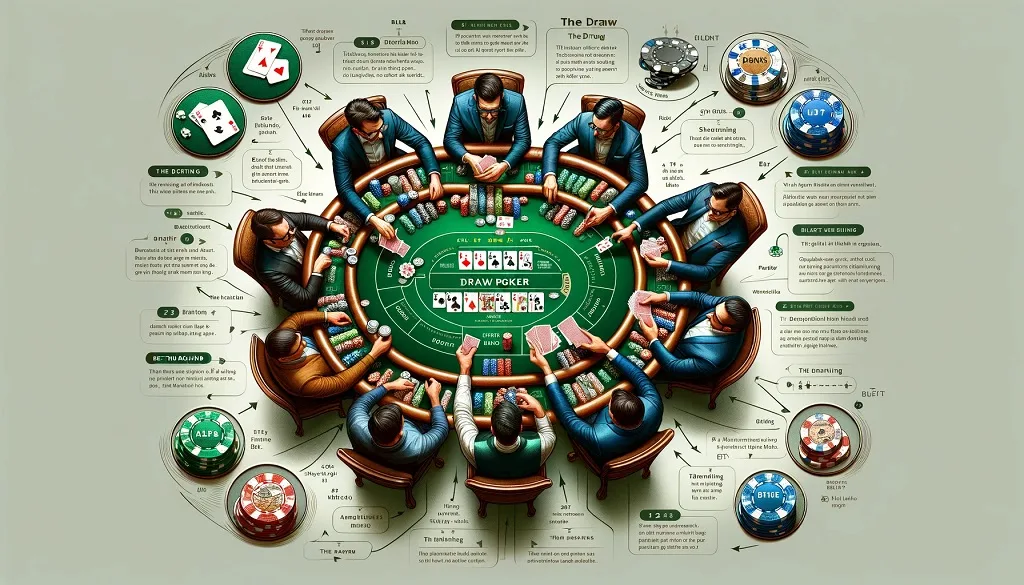
Ultimate Guide to Draw Poker: Mastering the Classic Game
Welcome to the ultimate guide on Draw Poker, a classic variant of poker that continues to captivate players around the globe. This comprehensive article will delve into the origins, unique characteristics, rules, tournament presence, and future prospects of Draw Poker, ensuring players of all levels are well-equipped to enjoy and excel at this timeless game.
When Was Draw Poker Invented?
The origins of Draw Poker trace back to the mid-19th century, emerging as a popular pastime on the American frontier. This era, characterized by saloons and the gold rush, provided a fertile ground for the game’s development. Draw Poker quickly distinguished itself from other card games of the time, offering a unique blend of strategy, skill, and the quintessential element of bluffing.
By the latter half of the 19th century, Draw Poker had solidified its presence, becoming a staple in saloons across the United States. Its appeal lay in its simplicity and the depth of strategy involved, making it a favorite among players of varying skill levels. The game’s evolution continued, paving the way for numerous variations that are still played today.
How Does It Differ From The Original?
Draw Poker stands out from other poker variants through its unique gameplay mechanics. Unlike Texas Hold’em or Omaha, where players share community cards, Draw Poker allows each player to hold their own hand, hidden from their opponents. This aspect intensifies the psychological element of the game, as players must make decisions based on limited information.
Furthermore, the opportunity to draw cards (exchange some of their cards with new ones from the deck) adds another layer of strategy. Players must carefully consider which cards to keep and which to exchange, all while attempting to read their opponents’ intentions. This dynamic significantly differs from other poker games, where the cards you’re dealt are the ones you play.
The betting rounds in Draw Poker also offer a distinct experience. With fewer rounds than in most modern poker games, each decision carries more weight, making for a more suspenseful and engaging gameplay experience.
What Are The Rules Of The Game?
The basic premise of Draw Poker involves each player being dealt a complete hand before the first betting round. Players then have the opportunity to exchange any number of their cards for new ones in an attempt to improve their hand. This process is followed by a second round of betting, after which the hands are revealed to determine the winner.
The game typically begins with an ante or blind, ensuring there’s always something to play for. After the initial deal, players assess the strength of their hands and proceed to the first round of betting. Strategic play and bluffing are crucial at this stage, as players must decide whether to stay in the hand based on their cards and their read of other players.
The draw phase follows, where players request cards to replace those they wish to discard. This crucial decision-making process can drastically alter the outcome of the game. After the draw, another round of betting ensues, ramping up the tension as players get closer to revealing their hands.
Showdown is the climax of Draw Poker, where players reveal their hands. The highest hand wins the pot, but the journey there is filled with strategic depth and psychological warfare, making each victory satisfying.
Variations of Draw Poker introduce additional rules and betting structures, offering a diverse range of experiences within the same foundational game. From Five-Card Draw to Badugi, each variation tests players’ skills in unique ways.

Are There Any Tournaments For This Version Of Poker?
While Texas Hold’em dominates the tournament scene, Draw Poker maintains a niche yet enthusiastic following in competitive play. Specialized tournaments and events often feature Draw Poker, showcasing the game’s enduring appeal and the high level of skill it demands from players.
These tournaments vary in size and scope, from local card rooms to larger, international poker festivals. They offer a platform for Draw Poker aficionados to demonstrate their mastery of the game, competing against like-minded individuals who appreciate its depth and strategic complexity.
Is There Any Prospect For This Variety?
Draw Poker’s future looks promising, thanks to a dedicated player base and the game’s inherent charm. Its simplicity, combined with the rich strategic depth, ensures it remains a favorite among traditional and new players alike.
As poker continues to evolve, Draw Poker retains its place as a fundamental variant, serving as both a stepping stone for beginners and a complex challenge for seasoned players. Its adaptability and enduring popularity suggest that Draw Poker will continue to be celebrated and played for generations to come

